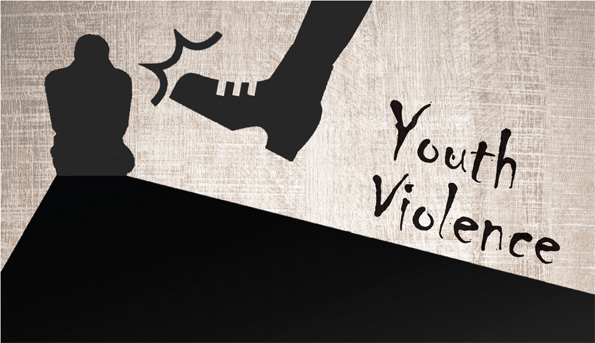
Last September, there was an instance of youth violence where four middle school students assaulted a girl for an hour and a half in Busan. A CCTV video that showed the girl kneeling down bleeding and the perpetrators attacking her raised public indignation. After that, every youth crime, whether it occurred in Gang-neung or other cities, was re-examined, and the government made measures to tackle the problem. However, those were not exact solutions, and the problem has been continuing. Now, youth crime has increased to a serious level. -Ed.
It was not a recent case, but the government presented various precautionary measures, like a revision of the perpetrators’ punishment measures and making a hotline for school violence. The regulations included apologies to victim students in writing, school service, community service, and the prohibition of threats or retaliation against students who have been injured. In addition, the government might implement special education or psychotherapy by experts, suspension, school transfer, or expulsion from a school. If the perpetrators are less than 14 years old, they will be put on probation. However, if they are 14 years old or older, they can be punished according to the degree of violence. Despite the efforts of the government, there are opinions that these measures are ineffective. Some people demand amendments of the laws concerning juvenile perpetrators’ punishments. Also, the School Violence Counseling Hotline received public criticism as being just window dressing. To solve this problem, the government has initiated counseling where a counselor visits the victims even if they don’t request help, an amendment of the juvenile law, and a method of expanding youth counseling manpower.
Cha Yong-bok, who works as the head of Sunshine Center of the Council Department for the Families of Victims of School Violence, said, “Although the laws of prevention and measures against school violence have been implemented since 2004, support and measures for victims are still lacking. School violence victims can’t get help outside of the school. As a result, they cannot but endure the psychological pain of co-existing with assailants at the same place where the violence occurred. It is necessary that victims should be provided with various supporting services, such as counseling, while they are feeling psychological instability at the school. It is also necessary to establish a special organization in exclusive charge of the students who have suffered from school violence to guarantee them protection for a certain period of time in order to re-establish psychological stability.”
There are many reasons why youth violence has occurred. Distortion from the incorrect perception of information processing is one important cause. Furthermore, youths who commit violence make mistakes in problem-solving. Experts and victim’s parents often complain that the assailant students’ parents don’t admit their fault. Because if they get punishment, assailant students will not be able to get a job or will receive a penalty for getting a future job. However, if they don’t admit their misdeed, it is hard for students to feel guilty. Also, the home and surrounding environments have a huge influence on teenagers. If the role of the family does not work well, the family will collapse on itself. Lastly, a lack of prevention of school violence is probably the biggest cause.
In foreign countries, efforts are made to prevent youth crime. First, in Norway, they hold class conferences frequently to educate students not to be bystanders when youth crime occurs. In addition, they teach students to shout, ‘Stop!’ instinctively when they see violent scenes. It has had a great influence on students’ independent actions against school violence. They also hold a seminar called Zero Program where the principals, teachers, parents and students participate. In Finland, there is the Kiva Koulu Project, which is a program to prevent school violence and provide psychotherapy. The core goal of the Kiva Koulu Project is to impress on students that school violence is not only for victims and assailants but also for all the members of the school. From the first grade through middle school, students attend weekly classes to respond actively to school violence. With this effort, the rate of victimized students in Finland has fallen from 16%(2009) to 14%(2014). The rate of criminal students has fallen from 12%(2009) to 7%(2014). In France, there is a national system to prevent school violence. For example, there is a Teacher Supporter System where teachers become supporters for 2 to 4 students and establish trust by counselling about course matters, friendship conflicts and their personal difficulties. In Japan, there is training for teachers to prepare countermeasures against school violence and intensify the capability of student guidance. In addition, they become acquainted with the laws associated with school violence and display professionalism while preventing school violence. The difference between those countries and Korea is that the other countries try to prevent other students from being bystanders and set a high value on the efforts of teachers to prevent school violence. Choi Jeong-won (’17, Dept. of Chemistry Education) said, “Although education about school violence prevention is mandatory, I think the biggest priority is to inform students. However, schools do not deem it a serious matter, so students do not know how serious school violence is. Awareness of the dangers of school violence is required when teaching students. Preventive education should be provided for students who think, ‘I can be a victim or an assailant of school violence.’ The ages of students who are involved in violence is getting younger. However, I think if there is an instructor who guides students about all school issues, the problem will be quickly solved.”
By Park Joo-hyun l jh38@cbnu.ac.kr
By Jo Se-in l si38@cbnu.ac.kr



 All
All Feature
Feature






 Park Joo-hyun
Park Joo-hyun











